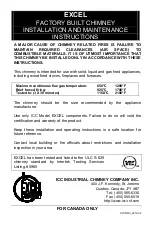
EN
44
CAUTION:
DO NOT CONNECT TO, OR USE IN CONJUNCTION
WITH ANY AIR DISTRIBUTION DUCT WORK
UNLESS SPECIFICALLY APPROVED FOR SUCH
INSTALLATION.
CAUTION:
DO NOT BURN GARBAGE OR FLAMMABLE LIQUIDS
SUCH AS GASOLINE, NAPTHA OR ENGINE
OIL. SOME FUELS COULD GENERATE CARBON
MONOXIDE AND ARE VERY DANGEROUS.
DO NOT BURN:
• Treated wood
• Coal
• Garbage
• Cardboard
• Solvents
• Colored Paper
• Trash
• Salt drift wood
• Cut lumber, plywood, mill ends.
Burning treated wood, garbage, solvents, colored paper or trash
may result in release of toxic fumes. Burning coal, cardboard, or
loose paper can produce soot, or large flakes of char or fly ash.
Whether you burn wood in a fireplace, or insert, good quality
firewood is the key to convenience, efficiency and safety. Wet
wood and pieces that are not the right size and shape for your
wood burner can be frustrating, burn inefficiently and deposit
creosote that can fuel a dangerous chimney fire. Good planning,
seasoning and storage of the firewood supply are essential to
successful wood burning.
• Stack the wood in separate rows in an open location where
the summer sun can warm it and breezes can carry away the
moisture. Do not stack unseasoned wood tightly in an unvented
storage area.
• Do not allow firewood to lie on the ground for more than a
couple of days before stacking. Mould and rot can set in quickly.
• Stack the wood up off the ground on poles, lumber rails or
pallets.
• The top of the pile can be covered to keep off rain, but do not
cover the sides.
Softer woods like pine, spruce and poplar/aspen that is cut, split
and stacked properly in the early spring maybe be ready for
burning in the fall. Extremely hard woods like oak and maple, and
large pieces of firewood, may take a minimum of a full year to dry
enough. Drying may also take longer in damp climates.
There are a few ways to tell if wood is dry enough to burn
efficiently. Use as many indicators as possible to judge the dryness
of the firewood your are considering. Here are ways to judge
firewood moisture.
• Using a moisture meter, select the species of fuel and then
penetrate the pins into a split piece. Ideal moisture and
seasoned firewood should be less than 20% moisture content.
• Checks or cracks in the end grain can be an indication of
dryness, but may not be a reliable indicator. Some wet wood has
checks and some dry wood has no checks.
• The wood tends to darken from white or cream colour to grey
or yellow as it dries.
• Two dry pieces banged together sound hollow; wet pieces sound
solid and dull.
• Dry wood weighs much less than wet wood.
• Split a piece of wood. If the exposed surface feels damp, the
wood is too wet to burn.
Seasoned Firewood
Creosote -- Formation and need for Removal
When wood is burned slowly, it produces tar and other
organic vapors, which combine with expelled moisture to form
creosote. The creosote vapors condense in the relatively
cool chimney flue of a slow-burning fire. As a result, creosote
residue accumulates on the flue lining. When ignited this
creosote makes an extremely hot fire.
Establish a routine for the fuel, wood burner and firing
technique. Check daily for creosote build-up until experience
shows how often you need to clean to be safe. Be aware that
the hotter the fire the less creosote is deposited, and weekly
cleaning may be enough in the coldest months. Contact your
local municipal or provincial fire authority for information on
how to handle a chimney fire. Have a clearly understood plan to
handle a chimney fire.
operating instructions
Summary of Contents for Contura Ri50
Page 30: ...EN 30 5 6 8 mm wrench or use crescent wrench installation ...
Page 40: ...1 2 3 4 EN 40 Installing the firebox cladding installation ...
Page 41: ...7 5 6 8 EN 41 installation ...
Page 42: ...11 9 10 EN 42 installation ...
Page 50: ...EN 50 maintenance ...
Page 51: ...EN 51 Replace front glass First 2 1 Remove side glass maintenance ...
Page 52: ...EN 52 maintenance ...
Page 53: ...EN 53 Replace gasket door First 3 1 2 Remove side glass Remove front glass maintenance ...
Page 54: ...EN 54 maintenance ...
Page 55: ...EN 55 maintenance ...
Page 56: ...EN 56 maintenance ...
Page 57: ...EN 57 PRESS PRESS maintenance ...
Page 58: ...EN 58 maintenance ...
Page 59: ...EN 59 Remove gasket back 4 maintenance ...
Page 60: ...EN 60 maintenance ...
Page 61: ...EN 61 Remove door 5 maintenance ...
Page 62: ...EN 62 maintenance ...
Page 63: ...EN 63 maintenance ...
Page 65: ...EN 65 maintenance ...
Page 66: ...EN 66 maintenance ...
Page 67: ...391697 Assembled Door Spare part number EN 67 Replacement parts parts list ...
Page 68: ...EN 68 Replacement parts Left or Right parts list ...
Page 77: ...NOTES ...
Page 79: ......
Page 80: ...NOTES ...
Page 81: ...EN 81 notes ...
Page 82: ...EN 82 notes ...
Page 83: ......
















































